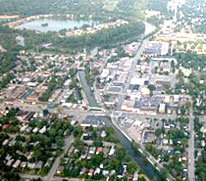
|
Broad Ripple Random Ripplings

The news from Broad Ripple
Brought to you by The Broad Ripple Gazette
(Delivering the news since 2004, every two weeks)

|
| Brought to you by: |

|

|

|

|

|

|
Converted from paper version of the Broad Ripple Gazette (v01n14)
Reminiscences of Old Broad Ripple - by Paul Walker
posted: Nov. 12, 2004

This is a new column by long-time Broad Ripple resident Paul Walker. In each issue Paul recalls growing up in Broad Ripple, north of the canal.
From your editor: The second part of chapter six will appear in a later issue. -AH
In 1925, the Walker family moved from a comfortable double at 2960 E Michigan Street to a country village six miles north of town called Broad Ripple. The route out there was College Avenue, unpaved, sometimes muddy, with cornfields on both sides of the street. The streetcar line ran down the middle of the street and was higher than the sides of the street, and could only be crossed by dirt ramps, at corners that now have traffic signals. There was a turn-around at 46th Street and another at Broad Ripple Park. The streetcar line was owned by the Union Traction Company, which used the track with their big, red, interurban rail cars. At 63rd street in Broad Ripple, motormen of both types of rail cars had to make sure the switch was set correctly for them. On one occasion a streetcar ran wild down College Avenue from the hill at 59th Street, jumped the switch, and slammed into the steel abutment of the traction bridge.
The traction cars ran all over Indiana; some long lines, some short, such as to Martinsville and Fort Harrison. One line that ran to Louisville had a train of these cars, featuring a mail car, a sleeper, and a diner. The traction company built Broad Ripple Park, which was very popular and brought a lot of business to the company and area.
Our double on Michigan Street, although not new, had hardwood floors, a full basement with a coal furnace, and all the utilities. The house on Ferguson Street in Broad Ripple was farmhouse style, two-story, half unpaved basement, no water, no furnace, no lights, no sewer, and no gas. It had a drilled well with a pump on the open-air back porch, which did not work half of the time, and froze up in winter. There was a cistern beneath the back porch into which rainwater ran, thru down-spouts, from the gutters. This was used for bathing and hair washing, which left one's hair very soft compared to well water which was hard with lime. Bathing was accomplished by sitting or standing in a wash tub in the middle of the kitchen. In winter, a nearby wood-burning cook stove kept one cozy. Hopefully one did not get too close!
When we had no drinking water, owing to a faulty pump, we boys carried buckets to Hoovers' house 100 yards away and used their pump. The bucket of fresh water stood in the kitchen where it was accessed by a dipper. Mr. Hoover, besides being a plasterer, paper-hanger, painter and garden plower, also drilled wells.
We had no indoor bathroom, necessitating a privy. This was situated about 60 feet from our water well. Sanitary? All houses in old Broad Ripple had privies. As the utilities and sewers moved north by stages, privies were abandoned in favor of modern facilities. A widely circulated tale was to the effect that a certain lady, who weighed over 300 pounds, fell through the floor of her out-house. This required the use of "six men and a block and tackle" to pull her out. As we walked home from Public School 80, down the alley, these old structures remained for years, waiting for the wrecking crew.
info@broadripplegazette.com

|

|

|
| Brought to you by: |

|

|

|
| Brought to you by: |

|

|

|
| Brought to you by: |

|

|

|
| Brought to you by: |


